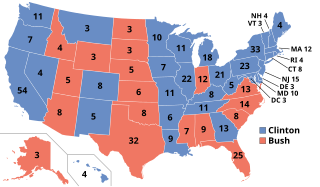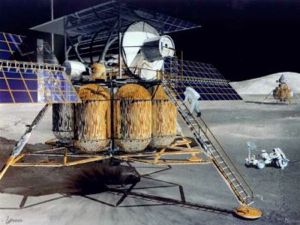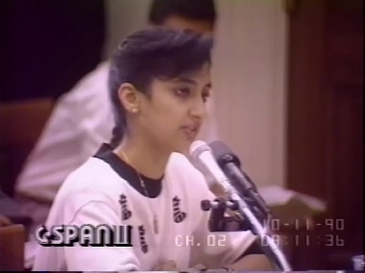 W
WThe presidency of George H. W. Bush began at noon EST on January 20, 1989, when George H. W. Bush was inaugurated as the 41st President of the United States, and ended on January 20, 1993. Bush, a Republican from Texas, took office after a landslide victory over Democrat Michael Dukakis in the 1988 presidential election. Following his defeat, he was succeeded by Democrat Bill Clinton, who won the 1992 presidential election.
 W
WThe United States federal government shutdown of 1990 occurred over the 1990 Columbus Day weekend, from Saturday, October 6 through Monday, October 8. The shutdown stemmed from the fact that a deficit reduction package negotiated by President George H. W. Bush contained tax increases, despite his campaign promise of "read my lips: no new taxes", leading to a revolt led by House Minority Whip Newt Gingrich that defeated the initial appropriations package. Because the shutdown occurred over a weekend, the effects of the shutdown were lessened, with the National Parks and the Smithsonian museums being the most visible closures. Around 2,800 workers were furloughed, with the government losing $2.57 million in lost revenue and back wages.
 W
WThe 1992 United States presidential election was the 52nd quadrennial presidential election, held on Tuesday, November 3, 1992. Democratic Governor Bill Clinton of Arkansas defeated incumbent Republican President George H. W. Bush, independent businessman Ross Perot of Texas, and a number of minor candidates. This election marked the end of a period of Republican dominance that began back in 1968, as the Democratic party would go on to win the popular vote in 6 of the following seven elections.
 W
W"Bush legs" is a prevailing term in the post-Soviet states that denotes chicken leg quarters from the United States.
 W
WThe C&O desk is one of only six desks ever used by a President of the United States in the Oval Office. Of all the Oval Office desks this one was used there only by George H. W. Bush. The C&O desk, built around 1920, is one of four desks built for the owners of the Chesapeake and Ohio Railway (C&O). It was later donated to the White House by Chesapeake and Ohio's successor, CSX Transportation.
 W
WThe Chicken Kiev speech is the nickname for a speech given by the United States president George H. W. Bush in Kyiv (Kiev), Ukraine, on August 1, 1991, 3 weeks before the Declaration of Independence of Ukraine and 4 months before the December independence referendum in which 92.26% Ukrainians voted to withdraw from the Soviet Union, in which Bush cautioned against "suicidal nationalism". 145 days after the speech, the Soviet Union collapsed, partially pushed by Ukraine. The speech was written by Condoleezza Rice—later Secretary of State under President George W. Bush—when she was in charge of Soviet and Eastern European affairs for the first President Bush. It outraged Ukrainian nationalists and American conservatives, with the conservative New York Times columnist William Safire calling it the "Chicken Kiev speech" in protest at what he saw as its "colossal misjudgment" for the very weak tone and miscalculation.
 W
WThe Decade of the Brain was a designation for 1990–1999 by U.S. president George H. W. Bush as part of a larger effort involving the Library of Congress and the National Institute of Mental Health of the National Institutes of Health "to enhance public awareness of the benefits to be derived from brain research".
 W
WFirst Lunar Outpost was a proposal for a manned lunar mission that would have launched sometime in the 2010s. It was part of George H. W. Bush's Space Exploration Initiative. The main purpose of the proposal was to offer a much cheaper alternative to NASA's 90-day study from 1989 by a factor of $30 billion. Although it did not gather much mainstream attention, NASA dedicated much time to assembling a very detailed and thorough proposal. However, the entire Space Exploration Initiative was cancelled soon after the proposal's completion, and NASA had to close the Office of Space Exploration in March of 1993.
 W
WThe Gulf War, codenamed Operation Desert Shield for operations leading to the buildup of troops and defense of Saudi Arabia and Operation Desert Storm in its combat phase, was a war waged by coalition forces from 35 nations led by the United States against Iraq in response to Iraq's invasion and annexation of Kuwait arising from oil pricing and production disputes.
 W
WThe Helsinki Summit comprised a meeting between US President George H. W. Bush and Soviet General Secretary Mikhail Gorbachev, taking place on September 9, 1990, just a few weeks before the reunification of Germany and just one month after the Iraqi invasion of Kuwait as their fourth meeting following a meeting that included Ronald Reagan, in New York in December 1988. Furthermore, the collapse of communism and the pending reunification of Germany necessitated a third summit meeting of the Commission on Security and Cooperation in Europe in order to formally end the Cold War.
 W
WThe inauguration of George H. W. Bush as the 41st President of the United States was held on Friday, January 20, 1989, at the West Front of the United States Capitol in Washington, D.C. This was the 51st inauguration and marked the commencement of the only term of both George H. W. Bush as President and Dan Quayle as Vice President. Chief Justice William Rehnquist administered the presidential oath of office to Bush and Justice Sandra Day O'Connor administered the vice-presidential oath of office to Quayle. Bush was the first sitting vice president to be inaugurated as president since Martin van Buren in 1837 and – as of 2019 – is the last vice president to be sworn-in as president.
 W
WThis is a list of international presidential trips made by George H. W. Bush, the 41st president of the United States. George H. W. Bush made 26 international trips to 58 different countries on six continents—Africa, Asia, Australia, Europe, North America, and South America—during his presidency, which began on January 20, 1989 and ended on January 20, 1993.
 W
WFollowing is a list of all Article III United States federal judges appointed by President George H. W. Bush during his presidency. All information is derived from the Biographical Directory of Federal Judges, a public-domain publication of the Federal Judicial Center. In total Bush appointed 193 Article III federal judges, including 2 Justices to the Supreme Court of the United States, 42 judges to the United States Courts of Appeals, 148 judges to the United States district courts and 1 judge to the United States Court of International Trade. In his single term in office, Bush tied Franklin D. Roosevelt's mark of 193 Article III federal judicial appointments over the course of his presidency.
 W
WThe 1992 Los Angeles riots, sometimes called the 1992 Los Angeles uprising, were a series of riots and civil disturbances that occurred in Los Angeles County in April and May 1992. Unrest began in South Central Los Angeles on April 29, after a trial jury acquitted four officers of the Los Angeles Police Department (LAPD) for usage of excessive force in the arrest and beating of Rodney King, which had been videotaped and widely viewed in TV broadcasts.
 W
WMedal of Honor Day is a United States federal observance that is celebrated every year on March 25. It was created to honor the "heroism and sacrifice of Medal of Honor recipients for the United States." The holiday has been celebrated since 1991, when George H. W. Bush signed Public Law 101-564 on November 15, 1990, which was passed by the 101st United States Congress in November 1990, and created it. The holiday was chosen to be celebrated on March 25 to honor the 23 men who participated in the Great Locomotive Chase and received Medals of Honor for it, particularly William Bensinger, Robert Buffum, Elihu H. Mason, Jacob Parrott, William Pittenger, and William H. H. Reddick, who received the first six Medals of Honor on March 25, 1863. The law reads :Whereas the Medal of Honor is the highest distinction that can be awarded by the president, in the name of the congress, to members of the armed forces who have distinguished themselves conspicuously by gallantry and intrepidity at the risk of their lives above and beyond the call of duty ... Whereas public awareness of the importance of the Medal of Honor has declined in recent years; and Whereas the designation of National Medal of Honor Day will focus the efforts of national, State, and local organizations striving to foster public appreciation and recognition of Medal of Honor recipients."
 W
WThe Nayirah testimony was a false testimony given before the United States Congressional Human Rights Caucus on October 10, 1990 by a 15-year-old girl who provided only her first name, Nayirah. The testimony was widely publicized, and was cited numerous times by United States senators and President George H. W. Bush in their rationale to back Kuwait in the Gulf War. In 1992, it was revealed that Nayirah's last name was al-Ṣabaḥ and that she was the daughter of Saud Al-Sabah, the Kuwaiti ambassador to the United States. Furthermore, it was revealed that her testimony was organized as part of the Citizens for a Free Kuwait public relations campaign, which was run by the American public relations firm Hill & Knowlton for the Kuwaiti government. Following this, al-Sabah's testimony has come to be regarded as a classic example of modern atrocity propaganda.
 W
WSTART I was a bilateral treaty between the United States of America and the Union of Soviet Socialist Republics (USSR) on the reduction and limitation of strategic offensive arms. The treaty was signed on 31 July 1991 and entered into force on 5 December 1994. The treaty barred its signatories from deploying more than 6,000 nuclear warheads atop a total of 1,600 inter-continental ballistic missiles (ICBMs) and bombers. START negotiated the largest and most complex arms control treaty in history, and its final implementation in late 2001 resulted in the removal of about 80 percent of all strategic nuclear weapons then in existence. Proposed by United States President Ronald Reagan, it was renamed START I after negotiations began on the second START treaty.
 W
WSTART II was a bilateral treaty between the United States of America and Russia on the Reduction and Limitation of Strategic Offensive Arms. It was signed by United States President George H. W. Bush and Russian President Boris Yeltsin on 3 January 1993, banning the use of multiple independently targetable reentry vehicles (MIRVs) on intercontinental ballistic missiles (ICBMs). Hence, it is often cited as the De-MIRV-ing Agreement. Despite negotiations, it never entered into effect. It was ratified by the U.S. Senate on 26 January 1996 with a vote of 87–4. Russia ratified START II on 14 April 2000, but on 14 June 2002, withdrew from the treaty in response to U.S. withdrawal from the ABM Treaty.
 W
WOn July 1, 1991, President George H. W. Bush nominated Clarence Thomas for the Supreme Court of the United States to replace Thurgood Marshall, who had announced his retirement. The nomination proceedings were contentious from the start, especially over the issue of abortion, and many women's groups and civil rights groups opposed Thomas on the basis of his conservative political views, as they had also opposed Bush's Supreme Court nominee from the previous year, David Souter.
 W
WThe United States Invasion of Panama, codenamed Operation Just Cause, lasted over a month between mid-December 1989 and late January 1990. It occurred during the administration of President George H. W. Bush and ten years after the Torrijos–Carter Treaties were ratified to transfer control of the Panama Canal from the U.S. to Panama by 1 January 2000. During the invasion, de facto Panamanian leader, general and dictator Manuel Noriega, who for a long time worked with the Central Intelligence Agency, was deposed citing racketeering and drug trafficking. Following the operation, the Panama Defense Forces were dissolved and President-elect Guillermo Endara was sworn into office.
 W
WOn January 8, 1992, about 8:20 p.m JST, while attending a banquet hosted by the Prime Minister of Japan, Kiichi Miyazawa, U.S. President George H. W. Bush fainted after vomiting in Miyazawa's lap. Doctors have since attributed the incident to a case of acute gastroenteritis.
 W
WWolfowitz Doctrine is an unofficial name given to the initial version of the Defense Planning Guidance for the 1994–99 fiscal years published by US Under Secretary of Defense for Policy Paul Wolfowitz and his deputy Scooter Libby. Not intended for public release, it was leaked to the New York Times on March 7, 1992, and sparked a public controversy about U.S. foreign and defense policy. The document was widely criticized as imperialist, as the document outlined a policy of unilateralism and pre-emptive military action to suppress potential threats from other nations and prevent dictatorships from rising to superpower status.